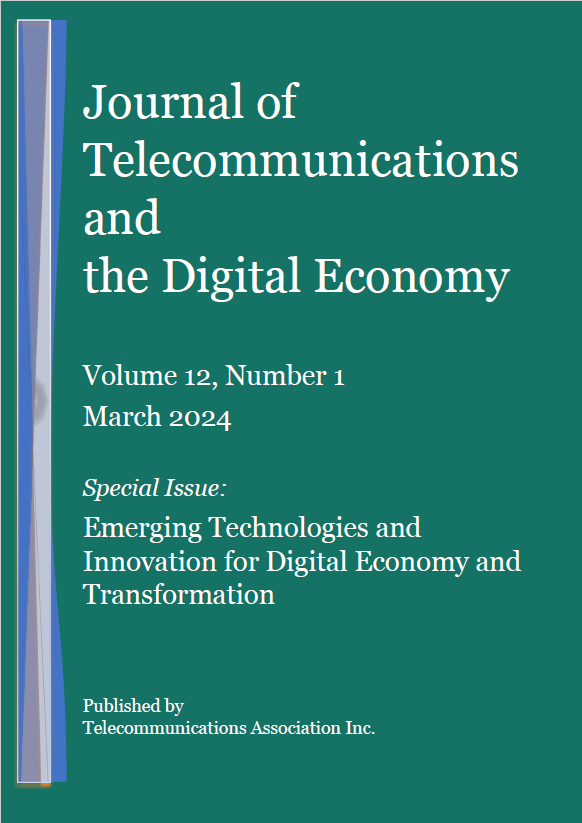Fusion-Based 2.5D Face Recognition System
Main Article Content
Keywords
fusion-based approach, depth image, 2.5D data, Gabor-based Region Covariance Matrices, 2.5D face recognition
Abstract
Face recognition is the dominant biometrics system used to authenticate an individual’s identity in various applications. Most commercial face recognition systems rely on 2D face images, but the changes in the environment lighting and a person's posture affect the accuracy of the 2D face recognition systems. Hence, the 2.5D face recognition system arises as the solution to eliminate the drawbacks of the 2D face recognition system. The depth feature in the 2.5D data (depth image) provides additional information that can help to improve the accuracy and robustness of 2.5D face recognition systems, particularly in challenging scenarios. This paper proposes a fusion-based approach for the 2.5D face recognition system to enhance the system’s performance, where feature fusion involves the combination of features extracted from the depth image. Gabor-based Region Covariance Matrices (GRCMs) that serve as face identifiers combine the depth and texture images in the structure of a covariance matrix. Several experiments on different fusions have been conducted in the Face Recognition Grand Challenge version 2 (FRGC v2.0) database. This paper shows that the max-min fusion applied to the surface normal (y-direction) and the mean curvature has achieved the best accuracy rate of 93.66% among the other fusion approaches used.
References
Chong, L. Y., Ong, T. S., & Teoh, A. B. J. (2019). Feature fusions for 2.5D face recognition in Random Maxout Extreme Learning Machine. Applied Soft Computing, 75, 358–372. https://doi.org/10.1016/j.asoc.2018.11.024
Chong, L. Y., Teoh, A. B. J., & Ong, T.-S. (2016). Range Image Derivatives for GRCM on 2.5D Face Recognition. In K. J. Kim & N. Joukov (Eds), Information Science and Applications (ICISA) 2016 (Vol. 376, pp. 753–763). Springer Singapore. https://doi.org/10.1007/978-981-10-0557-2_73
Chong, L. Y., Teoh, A. B. J., & Ong, T.-S. (2017). PCA filter based covariance descriptor for 2.5D face recognition. Proceedings of the 2017 International Conference on Biometrics Engineering and Application - ICBEA ’17, pp. 13–20. https://doi.org/10.1145/3077829.3077832
Chong, L. Y., Teoh, A. B. J., Ong, T.-S., & Chong, S.-C. (2014). 2.5D Face Recognition under Tensor Manifold Metrics. In C. K. Loo, K. S. Yap, K. W. Wong, A. T. Beng Jin & K. Huang (Eds), Neural Information Processing (Vol. 8836, pp. 653–660). Springer International Publishing. https://doi.org/10.1007/978-3-319-12643-2_79
Dutta, K., Bhattacharjee, D., Nasipuri, M., & Krejcar, O. (2021). Complement component face space for 3D face recognition from range images. Applied Intelligence, 51(4), 2500–2517. https://doi.org/10.1007/s10489-020-02012-8
Fang, L., He, N., Li, S., Plaza, A. J., & Plaza, J. (2018). A New Spatial–Spectral Feature Extraction Method for Hyperspectral Images Using Local Covariance Matrix Representation. IEEE Transactions on Geoscience and Remote Sensing, 56(6), 3534–3546. https://doi.org/10.1109/TGRS.2018.2801387
Kamencay, P., Hudec, R., Benco, M., & Zachariasova, M. (2014). 2D-3D Face Recognition Method Basedon a Modified CCA-PCA Algorithm. International Journal of Advanced Robotic Systems, 11(3), 36. https://doi.org/10.5772/58251
Kaur, H., Koundal, D., & Kadyan, V. (2021). Image Fusion Techniques: A Survey. Archives of Computational Methods in Engineering, 28(7), 4425–4447. https://doi.org/10.1007/s11831-021-09540-7
Liu, S., Chen, D., Chen, Z., Ru, C., & Pang, M. (2020). Research on Face Recognition Technology Based on ESN Multi Feature Fusion. https://doi.org/10.3966/160792642020092105029
Nhat, H. T. M., & Hoang, V. T. (2019). Feature fusion by using LBP, HOG, GIST descriptors and Canonical Correlation Analysis for face recognition. 2019 26th International Conference on Telecommunications (ICT), 371–375. https://doi.org/10.1109/ICT.2019.8798816
Pang, Y., Yuan, Y., & Li, X. (2008). Gabor-Based Region Covariance Matrices for Face Recognition. IEEE Transactions on Circuits and Systems for Video Technology, 18(7), 989–993. https://doi.org/10.1109/TCSVT.2008.924108
Phillips, P. J., Flynn, P. J., Scruggs, T., Bowyer, K. W., Chang, J., Hoffman, K., Marques, J., Min, J., & Worek, W. (2005). Overview of the Face Recognition Grand Challenge. 2005 IEEE Computer Society Conference on Computer Vision and Pattern Recognition (CVPR’05), 1, 947–954. https://doi.org/10.1109/CVPR.2005.268
Talab, M. A., Qahraman, N. A., Aftan, M. M., Mohammed, A. H., & Ansari, M. D. (2022). Local Feature Methods Based Facial Recognition. 2022 International Congress on Human-Computer Interaction, Optimization and Robotic Applications (HORA), 1–5. https://doi.org/10.1109/HORA55278.2022.9799910
Tosranon, P., Sanpanich, A., Bunluechokchai, C., & Pintavirooj, C. (2009). Gaussian curvature-based geometric invariance. 2009 6th International Conference on Electrical Engineering/Electronics, Computer, Telecommunications and Information Technology, 1124–1127. https://doi.org/10.1109/ECTICON.2009.5137242
Tuzel, O., Porikli, F., & Meer, P. (2006). Region Covariance: A Fast Descriptor for Detection and Classification. In A. Leonardis, H. Bischof, & A. Pinz (Eds), Computer Vision – ECCV 2006 (Vol. 3952, pp. 589–600). Springer Berlin Heidelberg. https://doi.org/10.1007/11744047_45
Vezzetti, E., & Marcolin, F. (2012). 3D human face description: Landmarks measures and geometrical features. Image and Vision Computing, 30(10), 698–712. https://doi.org/10.1016/j.imavis.2012.02.007
Vezzetti, E., Marcolin, F., & Fracastoro, G. (2014). 3D face recognition: An automatic strategy based on geometrical descriptors and landmarks. Robotics and Autonomous Systems, 62(12), 1768–1776. https://doi.org/10.1016/j.robot.2014.07.009






